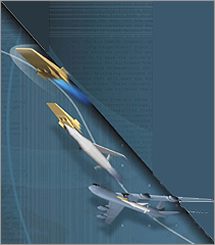 |
| NASA’s
Hyper-X studies use a three-stage approach: Each X-43
vehicle rides atop a Pegasus booster rocket carried
aloft by a
B-52 |
The technologies being studied as part of NASA’s Hyper-X program could bring a hypersonic bomber several steps closer to reality.
|
Engineers have already tested the program’s scramjet engine in a wind tunnel, and flight testing of three experimental vehicles is scheduled to begin in May.
The first of those experimental vehicles, the X-43A, has already been delivered to NASA’s Dryden Flight Research Center in Edwards, California. The 12-foot-long, unpiloted X-43A will ride atop a Pegasus booster rocket, which in turn will be air-launched by Dryden’s B-52 airplane. After separating from the rocket, the X-43A will conduct aerodynamic and propulsion experiments at a speed of Mach 7, then crash into the Pacific. Two more flight tests will be conducted later, at speeds of Mach 7 and Mach 10.
The X-43A will be the first vehicle with a non-rocket engine to reach hypersonic speeds, above Mach 5. Today, the world’s fastest air-breathing aircraft is NASA’s SR-71, which can reach speeds slightly above Mach 3.
If the Hyper-X tests are successful, they’ll provide data on which to build reusable vehicles with larger engines, including hypersonic bombers and reusable space launchers.